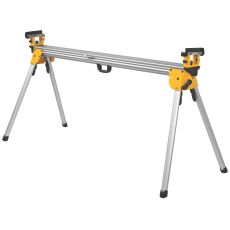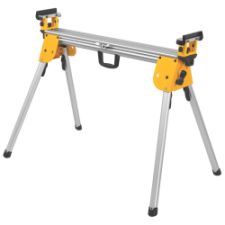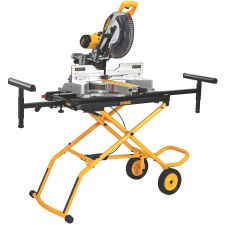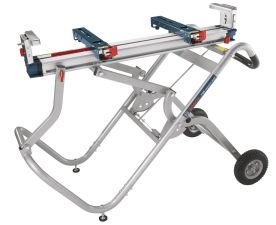A miter saw table or workstation is an important piece of equipment for both contractors and serious DIYers. The best miter saw stands make working with your tool easier and more efficient. They must also be able to stand up to the level of wear and tear you plan on giving them. There are stationary units as well as ones with wheels. There are a various features mixed and matched into different setups that have different advantages and disadvantages. It is important to be familiar with all of your options before making such an important (and pricey) purchase.
Our Top Four Recommendations
Below is a list of the best four miter saw stands that we recommend you take a look at. To find out more about a specific model, hit the “my review” link right below the stand.
DeWalt DWX723 Stand View Amazon.com's Price | DeWalt DWX724 Stand View Amazon.com's Price | DeWalt DWX726 Stand View Amazon.com's Price | Bosch T4B Stand View Amazon.com's Price |
|
| My Rating | 9.5/10 | 9.2/10 | 8.1/10 | 8.9/10 |
| Unit Weight | 35 lbs. | 29.8 lbs. | 67 lbs. | 76 lbs. |
| Supported Weight | 500 lbs. | 500 lbs. | 300 lbs. | 300 lbs. |
| Supported Material Length | 16 feet | 10 feet | 8 feet | 18 feet |
| My Review | My Review | My Review | My Review |
The Design of The Best Miter Saw Tables
Generally speaking, there are two main types of miter saw stands. There are wheeled units and then there are four-legged stationary ones.
Wheeled units allow movement without detaching your saw and there are different designs within this category. Some do a better job of reducing the weight you must shoulder yourself when adjusting and transporting them. There are simpler designs that you will have a harder time moving around but may just last longer due to having fewer moving parts. Many of them will convert to a configuration that takes up less floor space than the configuration for working your materials. Though it may spook some users, these stands will hold your saw while in the vertical position. The wheeled design also allows you to leave your saw on the stand between jobsites, granted you have a trailer to load it into or an extra hand or two to lift them into the truck.
The stationary units are better suited for those who don’t need to move their saw around within a jobsite. The designs are more rudimentary, thus some will last forever. Some are inordinately heavy but many fold up into shapes that can fit into trunks or be hung on walls. These are actually easier to move from jobsite to jobsite without the use of a trailer but you will, of course, have to remove your saw in order to transport.
It is important to note that most manufacturers advertise their stands as having a ‘universal design’ that is suitable for every saw, but considering how different all of their miter saws are you should know that this is something worth looking into. To use with other brands, many of these need some sort of rigging (likely drilling your own saw) to attach the saw to the clamps. But some of them are compatible with their competitors as is though, so you should research them on an individual basis.
Durability/Build Quality of The Table
For such a large purchase, it is important for your investment to stick around. In order to analyze this aspect of your potential stand, you need to be honest about the workload you intend to put it through. Sometimes you can get a hint about how long the company expects their product to last based on the warranty they put on it. It is important to notice things like number of joints and moving parts, how much of the design is metal, and overall weight.
Keep in mind that miter saw stands are one of the most important products for manufacturers to balance weight with durability so you need to make sure you are ready to handle those extra pounds if you need one that you can put through the paces every day. Wheeled stands are generally much heavier than the sawhorse style but the simplicity of the sawhorse style results I in superior durability. Wheeled stands are more for DIYers and indoor crews. The four-legged stands are better for crews that don’t need to move their saw around within the same jobsite and anyone else who never needs to move their saw.
Construction Stability
Too many DIYers (and professionals) set up their 3000+ RPM miter saws on rickety saw horses, trashcans, or even the floor! You can obviously make due, but this is one of the biggest reasons why miter saw stands make your work easier. You always know exactly how your work area is going to look and you if you make the right buy you can be sure that your quality of work is going to increase. With that being said, some just aren’t as solid as you would expect. Whether the legs just don’t lock well or the extensions sag under your materials, it is important to identify the level of stability provided by each model. This is one area where increased weight actually has a positive effect on your tool’s performance.
Ease of Use
With a social climate that emphasizes instant gratification and saving time, most manufacturers feel the pressure to make all of their tools quick to setup and easy to use. Miter saw workstations are one of those items that you will nearly always have to do some level of assembly and depending on how technically inclined you are, this may be a big deal. But the main issue is after the initial setup. Contractors and DIYers alike do not want to spend more time fiddling with their tools than putting them to work and most of these items have different quick adjustments for leg locks or extensions or work stops or saw attachment. But these small moving parts have high susceptibility to breakage so it is important to balance your convenience with the tools longevity in the decision making process.
Table Extensions
Extensions are the most common and most important feature you’ll find on a miter saw stand or workstation. In fact, it is the only feature that adds real value to your apparatus. You’ll first want to note how much material the entire thing can support so you’ll need to know how far out the arms extend as well as how wide they are (Often, the supports are so thin that it is difficult to balance your materials with casual effort.). Of equal import is how well they hold up to what weight. Some have capacities up over 500 lbs and are very sturdy fully extended while others sag with every new weight. The best engineered examples make it easy to adjust the lengths of the arms as well as the height of the supports when needed.
Many manufacturers add another dimension to this feature by adding either work stops or rollers. Work stops make it much more convenient to handle repeat cuts by giving you a sold surface to put the end of your material against. They are almost always setup to get in and out of your way quickly and easily. Rollers, meanwhile, are there to make it easy for you to move your material across the surface of the support. You should take into account which, if either, option will be the most valuable to you based on your own needs.
Final Advice
Your miter saw is almost definitely one of your most prized tools. You could consider your workstation its home. The more comfortable it is, the more comfortable you will be working with it. But considering the expense of this investment, be sure that you know exactly what it is you need and then exactly what it is you are paying for when you opt for this design over that one. They all have strengths and weaknesses but it is important to separate what aspects are necessities for you and which you can prioritize last or not at all. Generally speaking, you get what you pay for and you are always better off paying for a higher grade where you can afford it, especially when it is going to impact your quality of work as much as these do.
